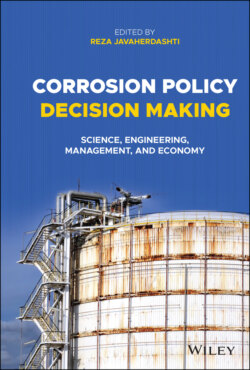Читать книгу Corrosion Policy Decision Making - Группа авторов - Страница 22
2.2.2 Chemical Treatment
ОглавлениеOne the ways by which corrosion can be brought under control is application of corrosion inhibitors, and in case of MIC, biocides. The reason we emphasize mentioning biocides along with corrosion inhibitors is the incorrect belief by some corrosionists that by applying inhibitors, MIC can also be treated, or rather, MIC is less important than non‐MIC corrosion problems. While MIC is also an electrochemical corrosion in essence, corrosion inhibitors (or nearly all of them) cannot treat MIC, as the contributing factor to corrosion is micro‐organisms.
Corrosion inhibitors can be grouped by selecting various criteria, but we prefer to categorize them into main three groups; anodic, cathodic, and mixed effect inhibitors.
Anodic inhibitors form a protective oxide film on the surface of the metal. This film will be instrumental in causing a large anodic shift of the corrosion potential. This shift forces the metallic surface into the passivation region where the material can be assumed to become immune to corrosion. Due to this effect, anodic corrosion inhibitors are also sometimes referred to as passivators. Chromates, nitrates, tungstate, and molybdates are some examples of anodic inhibitors. On the other hand, cathodic inhibitors act mainly via two mechanisms; either by slowing the cathodic reaction itself, or selectively precipitating on cathodic areas to limit the diffusion of reducing species to the surface. The mechanism of mixed effect corrosion inhibitors can be summarized as the three points below:
Mixed inhibitors work by reducing both the cathodic and anodic reactions. They are typically film‐forming compounds that cause the formation of precipitates on the surface, blocking both anodic and cathodic sites indirectly.
The most common inhibitors of this category are silicates and phosphates.
Silicates and phosphates do not afford the degree of protection provided by anodic inhibitors such as chromates and nitrites, however, they are very useful in situations where non‐toxic additives are required.
Biocides are chemicals that can serve to kill bacteria and this terminology is used particularly to address the bacteria contributing to MIC reactions. Biocides can be divided into oxidizing and non‐oxidizing, depending on the detrimental mechanism and effects on the targeted bacteria. Important features of biocides [2] as well as pros and cons of frequently used biocides [3] have been reviewed elsewhere.
The main point about both corrosion inhibitors and biocides is that as they are both classified as chemicals, their entrance into the environment must be carefully assessed and monitored on a systematic basis [4].
